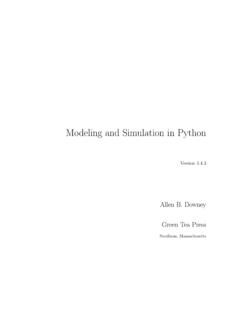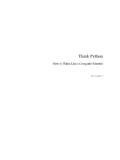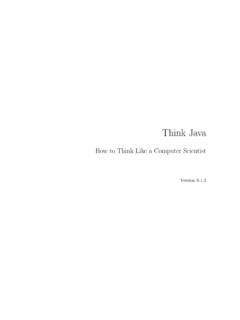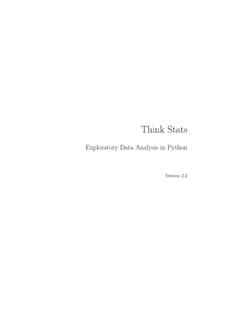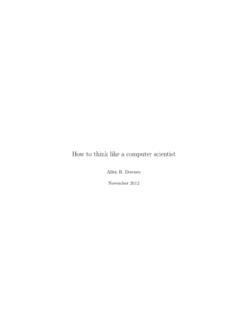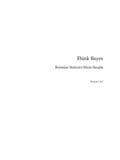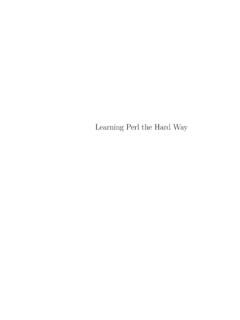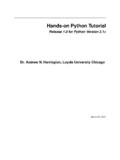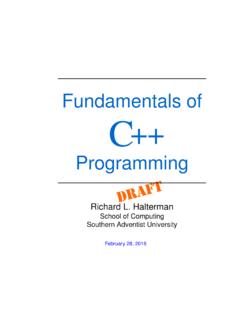Transcription of How to Think Like a Computer Scientist - Green …
1 How to Think like a Computer Scientist Learning with python ii How to Think like a Computer Scientist Learning with python Allen Downey Jeffrey Elkner Chris Meyers Green Tea Press Wellesley, Massachusetts c 2002 Allen Downey, Jeffrey Elkner, and Chris Meyers. Copyright Edited by Shannon Turlington and Lisa Cutler. Cover design by Rebecca Gimenez. Printing history: April 2002: First edition. Green Tea Press 1 Grove St. Box 812901. Wellesley, MA 02482. Permission is granted to copy, distribute, and/or modify this document under the terms of the GNU Free Documentation License, Version or any later version pub- lished by the Free Software Foundation; with the Invariant Sections being Foreword, . Preface, and Contributor List, with no Front-Cover Texts, and with no Back- Cover Texts. A copy of the license is included in the appendix entitled GNU Free Documentation License.. The GNU Free Documentation License is available from or by writing to the Free Software Foundation, Inc.
2 , 59 Temple Place, Suite 330, Boston, MA 02111- 1307, USA. The original form of this book is LATEX source code. Compiling this LATEX source has the effect of generating a device-independent representation of a textbook, which can be converted to other formats and printed. The LATEX source for this book is available from Publisher's Cataloging-in-Publication (provided by Quality Books, Inc.). Downey, Allen How to Think like a Computer Scientist : learning with python / Allen Downey, Jeffrey Elkner, Chris Meyers. 1st ed. p. cm. Includes index. ISBN 0-9716775-0-6. LCCN 2002100618. 1. python ( Computer program language) I. Elkner, Jeffrey. II. Meyers, Chris. III. Title 2002 '3. QBI02-200031. Foreword By David Beazley As an educator, researcher, and book author, I am delighted to see the com- pletion of this book. python is a fun and extremely easy-to-use programming language that has steadily gained in popularity over the last few years.
3 De- veloped over ten years ago by Guido van Rossum, python 's simple syntax and overall feel is largely derived from ABC, a teaching language that was developed in the 1980's. However, python was also created to solve real problems and it borrows a wide variety of features from programming languages such as C++, Java, Modula-3, and Scheme. Because of this, one of python 's most remark- able features is its broad appeal to professional software developers, scientists, researchers, artists, and educators. Despite python 's appeal to many different communities, you may still wonder why python ? or why teach programming with python ? Answering these questions is no simple task especially when popular opinion is on the side of more masochistic alternatives such as C++ and Java. However, I Think the most direct answer is that programming in python is simply a lot of fun and more productive. When I teach Computer science courses, I want to cover important concepts in addition to making the material interesting and engaging to students.
4 Un- fortunately, there is a tendency for introductory programming courses to focus far too much attention on mathematical abstraction and for students to be- come frustrated with annoying problems related to low-level details of syntax, compilation, and the enforcement of seemingly arcane rules. Although such abstraction and formalism is important to professional software engineers and students who plan to continue their study of Computer science, taking such an approach in an introductory course mostly succeeds in making Computer sci- ence boring. When I teach a course, I don't want to have a room of uninspired students. I would much rather see them trying to solve interesting problems by exploring different ideas, taking unconventional approaches, breaking the rules, vi Foreword and learning from their mistakes. In doing so, I don't want to waste half of the semester trying to sort out obscure syntax problems, unintelligible compiler error messages, or the several hundred ways that a program might generate a general protection fault.
5 One of the reasons why I like python is that it provides a really nice balance between the practical and the conceptual. Since python is interpreted, begin- ners can pick up the language and start doing neat things almost immediately without getting lost in the problems of compilation and linking. Furthermore, python comes with a large library of modules that can be used to do all sorts of tasks ranging from web-programming to graphics. Having such a practical focus is a great way to engage students and it allows them to complete signif- icant projects. However, python can also serve as an excellent foundation for introducing important Computer science concepts. Since python fully supports procedures and classes, students can be gradually introduced to topics such as procedural abstraction, data structures, and object-oriented programming all of which are applicable to later courses on Java or C++. python even borrows a number of features from functional programming languages and can be used to introduce concepts that would be covered in more detail in courses on Scheme and Lisp.
6 In reading Jeffrey's preface, I am struck by his comments that python allowed him to see a higher level of success and a lower level of frustration and that he was able to move faster with better results. Although these comments refer to his introductory course, I sometimes use python for these exact same reasons in advanced graduate level Computer science courses at the University of Chicago. In these courses, I am constantly faced with the daunting task of covering a lot of difficult course material in a blistering nine week quarter. Although it is certainly possible for me to inflict a lot of pain and suffering by using a language like C++, I have often found this approach to be counterproductive . especially when the course is about a topic unrelated to just programming. I. find that using python allows me to better focus on the actual topic at hand while allowing students to complete substantial class projects.
7 Although python is still a young and evolving language, I believe that it has a bright future in education. This book is an important step in that direction. David Beazley University of Chicago Author of the python Essential Reference Preface By Jeff Elkner This book owes its existence to the collaboration made possible by the Internet and the free software movement. Its three authors a college professor, a high school teacher, and a professional programmer have yet to meet face to face, but we have been able to work closely together and have been aided by many wonderful folks who have donated their time and energy to helping make this book better. We Think this book is a testament to the benefits and future possibilities of this kind of collaboration, the framework for which has been put in place by Richard Stallman and the Free Software Foundation. How and why I came to use python In 1999, the College Board's Advanced Placement (AP) Computer Science exam was given in C++ for the first time.
8 As in many high schools throughout the country, the decision to change languages had a direct impact on the Computer science curriculum at Yorktown High School in Arlington, Virginia, where I. teach. Up to this point, Pascal was the language of instruction in both our first-year and AP courses. In keeping with past practice of giving students two years of exposure to the same language, we made the decision to switch to C++. in the first-year course for the 1997-98 school year so that we would be in step with the College Board's change for the AP course the following year. Two years later, I was convinced that C++ was a poor choice to use for in- troducing students to Computer science. While it is certainly a very powerful programming language, it is also an extremely difficult language to learn and teach. I found myself constantly fighting with C++'s difficult syntax and mul- tiple ways of doing things, and I was losing many students unnecessarily as a viii Preface result.
9 Convinced there had to be a better language choice for our first-year class, I went looking for an alternative to C++. I needed a language that would run on the machines in our Linux lab as well as on the Windows and Macintosh platforms most students have at home. I wanted it to be free and available electronically, so that students could use it at home regardless of their income. I wanted a language that was used by professional programmers, and one that had an active developer community around it. It had to support both procedural and object-oriented programming. And most importantly, it had to be easy to learn and teach. When I investigated the choices with these goals in mind, python stood out as the best candidate for the job. I asked one of Yorktown's talented students, Matt Ahrens, to give python a try. In two months he not only learned the language but wrote an application called pyTicket that enabled our staff to report technology problems via the Web.
10 I knew that Matt could not have finished an application of that scale in so short a time in C++, and this accomplishment, combined with Matt's positive assessment of python , suggested that python was the solution I was looking for. Finding a textbook Having decided to use python in both of my introductory Computer science classes the following year, the most pressing problem was the lack of an available textbook. Free content came to the rescue. Earlier in the year, Richard Stallman had introduced me to Allen Downey. Both of us had written to Richard expressing an interest in developing free educational content. Allen had already written a first-year Computer science textbook, How to Think like a Computer Scientist . When I read this book, I knew immediately that I wanted to use it in my class. It was the clearest and most helpful Computer science text I had seen. It emphasized the processes of thought involved in programming rather than the features of a particular language.

